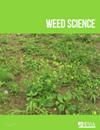Addressing biases in replacement series: the importance of reference density selection for interpretation of competition outcomes
IF 2.5
2区 农林科学
Q2 AGRONOMY
引用次数: 0
Abstract
Abstract Replacement series are used by researchers to understand how competition-related variables influence dynamics from the individual to the population and community levels, but this approach has been criticized because of inherent biases associated with plant size differences and density-dependent responses. The use of functional densities instead of demographic densities was proposed to minimize those biases. This work explored three models to determine reference densities for replacement series experiments based on 1) maximum biomass, 2) biomass at onset of diminishing returns (i.e., inflection point), and 3) N uptake equivalency. Replacement series experiments were conducted using redroot pigweed ( Amaranthus hybridus L.):maize ( Zea mays L.) and giant foxtail ( Setaria faberi Herrm.):maize proportions of 1:0, 0.75:0.25, 0.5:0.5, 0.25:0.75, and 0:1. The monoculture density for each species was established according to the three models. Density selection criteria resulted in major differences in competitive interactions between species. The use of functional densities at which the biomass accumulation inflection point for the smaller species allowed both species to exhibit either increases or decreases in biomass production depending on competitive interactions for all inter-specific mixtures. Conversely, the maximum biomass model favored the larger species almost completely inhibiting the growth of the smaller species, which resulted in a poor characterization of competitive responses of the smaller species. The N uptake equivalency model resulted in interactions closer to the predicted neutral competition. The model based on the biomass accumulation inflection point was the most sensitive and informative across all inter-specific mixtures for both species. We propose that to reduce bias associated with species size differences when determining reference densities for replacement series experiments, at least two criteria must be met: 1) the experiment sensitivity allows measuring and quantifying the competitive responses for both species in all mixtures, and 2) the balance between density and carrying capacity of the system minimizes intra-specific competition.解决替代序列中的偏差:参考密度选择对解释竞争结果的重要性
替代序列被研究人员用来了解竞争相关变量如何影响从个体到种群和群落水平的动态,但由于植物大小差异和密度依赖反应相关的固有偏差,这种方法受到了批评。有人建议使用功能密度而不是人口密度来减少这些偏差。本研究探索了三个模型来确定替代系列实验的参考密度,基于1)最大生物量,2)收益递减开始时的生物量(即拐点),以及3)N吸收当量。以红根藜(Amaranthus hybridus L.)、玉米(Zea mays L.)和毛缕草(Setaria faberi Herrm.):玉米的比例分别为1:0、0.75:0.25、0.5:0.5、0.25:0.75和0:1进行替代系列试验。根据这三个模型建立了各种属的单作密度。密度选择标准导致物种间竞争相互作用的主要差异。使用功能密度,即较小物种的生物量积累拐点,允许两个物种根据所有种间混合物的竞争相互作用表现出生物量产量的增加或减少。相反,最大生物量模型倾向于较大的物种,几乎完全抑制了较小物种的生长,这导致较小物种竞争响应的表征较差。氮吸收等效模型导致的相互作用更接近于预测的中性竞争。基于生物量积累拐点的模型在所有种间混合中都是最敏感和最具信息量的。我们建议,在确定替代系列实验的参考密度时,为了减少与物种大小差异相关的偏差,至少必须满足两个标准:1)实验灵敏度允许测量和量化所有混合物中两种物种的竞争响应;2)系统密度和承载能力之间的平衡使种内竞争最小化。
本文章由计算机程序翻译,如有差异,请以英文原文为准。
求助全文
约1分钟内获得全文
求助全文
来源期刊

Weed Science
农林科学-农艺学
CiteScore
4.60
自引率
12.00%
发文量
64
审稿时长
12-24 weeks
期刊介绍:
Weed Science publishes original research and scholarship in the form of peer-reviewed articles focused on fundamental research directly related to all aspects of weed science in agricultural systems. Topics for Weed Science include:
- the biology and ecology of weeds in agricultural, forestry, aquatic, turf, recreational, rights-of-way and other settings, genetics of weeds
- herbicide resistance, chemistry, biochemistry, physiology and molecular action of herbicides and plant growth regulators used to manage undesirable vegetation
- ecology of cropping and other agricultural systems as they relate to weed management
- biological and ecological aspects of weed control tools including biological agents, and herbicide resistant crops
- effect of weed management on soil, air and water.
 求助内容:
求助内容: 应助结果提醒方式:
应助结果提醒方式:


